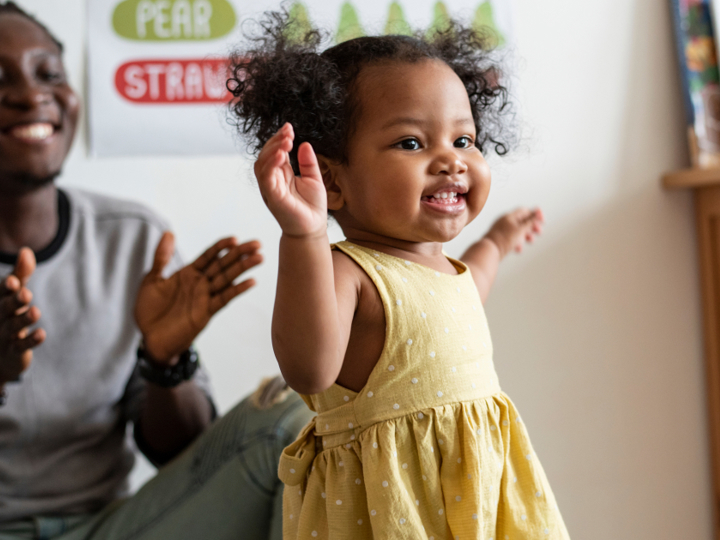Activities to support your baby's movement
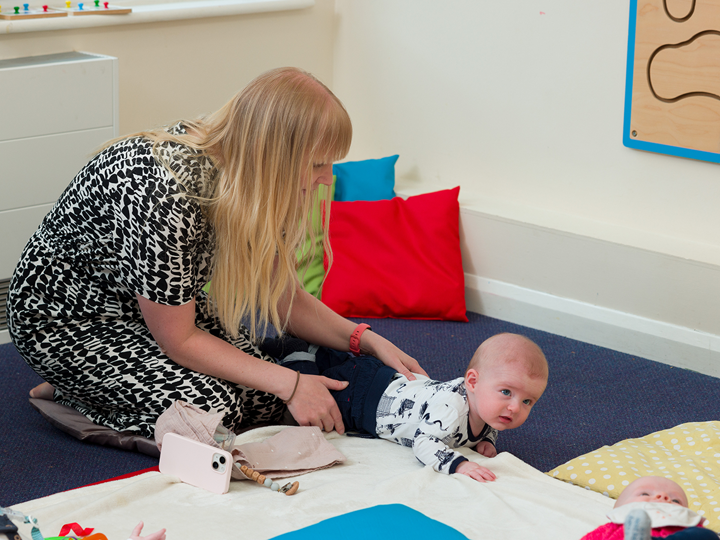
All babies develop at different rates. The information below aims to give you ideas to help your baby develop skills through play and exploring the world around them.
Your baby will then start using walls and furniture to get around. This is referred to as cruising. As your baby becomes more mobile make sure your home is completely baby proof and all furniture is secure.
Explore the topics on this page:
Learning to move
-
- If your baby is unable to bring hands forward, a towel can be used to provide extra support. Place this behind their shoulders and under the thighs.
- Once baby is more active and can bring their hands forwards to explore/play, the towel will not be needed.
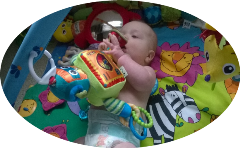
- Talk to your baby and encourage them to look at you.
- This helps baby to be supported in a curled up position and their head in the middle.
- Sing a song, lullaby or play peekaboo.
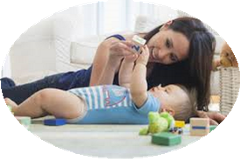
-
Bring your hands behind baby's shoulders to help them bring arms forwards. Encourage them to bring hands together, touch your face, hands or clothes. You can also introduce a soft toy for them to explore.
Song ideas
- "Wind the bobbin up... wind the bobbin up"
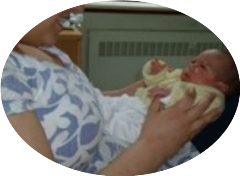
-
- This helps to develop muscles needed for sitting and crawling. Tummy time should be carried out when your baby is alert, awake and happy.
- Hold your baby on your chest or over your shoulder facing you. This will encourage them to lift their head and look around.
- A blanket can be rolled up and placed under baby’s chest for extra support
- Use bright toys to encourage your baby to reach out. This will help them to prop on their arms and lift their chest
- Encourage eye contact by getting down at baby’s level. This is a great time to sing songs, copy sounds and encourage baby. This is a great time to sing songs, copy sounds and encourage babble.
- Use a toy mirror, babies love looking at faces.
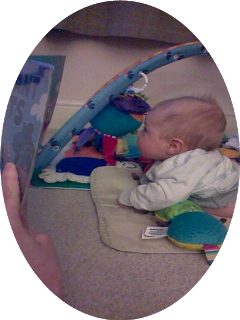
-
A rolled towel placed behind baby will give extra support, and stop them rolling backwards.
A toy will give them something to look at and explore. Try placing this at the level of baby’s chest.
Help your baby to roll by placing a toy to the side and just out of reach. Encourage them to reach for the toy. Support at the hips to guide them to roll onto tummy.
- This is a great position to copy noises, sing songs and encourage babble.
- Talk to your baby. Try counting 1...2…3 to help them anticipate rolling.
- Play mats and toys will help your baby explore different colours textures and sounds.
- Join in with your baby, and let baby see your face. This will help them feel more secure. You can use mirrors so that you can talk to your baby and see each others faces. Lots of smiles and encouragement will help your baby feel secure.
Song ideas
- “There were 10 in the bed and the little one said….roll over….roll over”
- “Twinkle Twinkle Little Star.”
Learning to sit
-
- Encourage your baby to look at you bringing their chin and head forwards as you sit up rather than leaving their head behind them.
- To encourage you baby to learn to sit up, sit your baby between your legs and rest their hands on your knees.
- Encourage baby to reach forwards for a toy or to prop on their arms bringing toys up on a book or pillow/or cushion helps your baby to sit up and lean through their hands.
- Bubbles can be used to encourage reaching forwards and to develop sitting balance.
- Your baby leaning through their hands is important to develop, when moving from sitting to crawling.
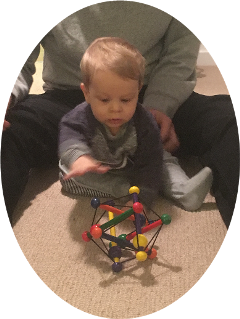
- Rear facing pushchair can help communication and allow you to interact with your child.
Song ideas
- "Horsey Horsey” with baby sitting astride your leg.
- "Row row row your boat” with baby sitting on your lap.
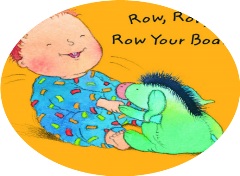
-
- Help your baby move through side lying to sitting pushing up through his/her hands. Let them do as much as they can themselves.
- Encourage your baby to come into upright sitting by using toys and encouraging him/her to reach.
-
Encourage independent sitting without support to develop balance. Over time your baby will be able to sit for longer periods of time on his/her own.
In sitting place some toys in front of your baby to encourage them to reach forwards and play.
To progress sitting balance motivate your baby to stretch out for toys that are further away. Place pillows around them in case they lose their balance.
- Play mats and toys will help your baby explore different colours textures and sounds.
- By building blocks or placing toys in a bucket in this position it will encourage your baby to sit tall.
- Blow bubbles when your baby is in a stable sitting position. If they catch one, they will see and feel it pop. This will help them learn about cause and effect.
- Rattles and toys that make noises encourage looking around.
- Lots of smiles and encouragement will help your baby feel secure.
- To improve social interaction place a mirror in front. Alternatively a second person could be in front to encourage play.
Song ideas
- “Wind the bobbin up….wind the bobbin up” or "twinkle twinkle little star".
- In this position you can sing "row, row, row the boat" supporting them at the shoulders and later hands held.
- To help develop your baby’s balance you can sing "horsey horsey" with them sitting astride your leg.
Learning to crawl
-
- Sitting between your legs, place a toy in front and to one side of your baby, when they reach forward guide them over onto their hands and knees.
- Using your leg to support them under their tummy is a good way of introducing this position.
- Lying on their tummy, encourage an independent crawling position by supporting your baby at the hips and then slowly reduce the support.
- Try and keep this crawling position whilst playing with toys to encourage weight shift through hands and knees.
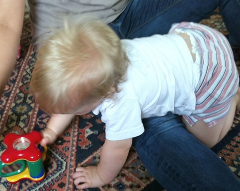
- Feely books or sensory books (which contain different music, textures or colours) can be used to put weight through alternate hands.
- Use a toy mirror, babies love looking at faces.
- Lots of praise and encouragement will help your baby feel confident.
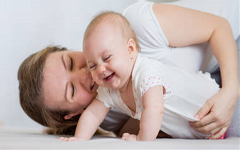
-
- Once your baby can achieve an independent crawling position, encourage them to pick up and place toys in a bucket.
- You can also position toys away from your baby so they have to crawl to get it. This is a good time to baby proof your house.
- Use a moving toy to motivate your baby to crawl.
- Place their favourite toy across the room to encourage them to look for it and crawl towards it.
- Encourage your baby to crawl to you, by giving lots of smiles and praise.
Song ideas
- ‘Horsey horsey don't you stop, Just let your feet go clippety-clop’
Learning to stand
-
- Place a toy at a higher level, for example on a small table, sofa or on a cushion on the floor.
- Encourage your baby to use their hands to play whilst propping up on their knees. Make sure their knees are directly under their hips.
- At a sofa level, place toys out of reach to your baby's right and left to get them to bring their weight over to one side.
- Guide your baby to bring one foot forwards. They may need a little lift under their bottom to assist them into standing.
- Place all favourite toys up high to encourage them to pull up into standing.
- Use musical instruments at a higher level i.e. banging a drum/xylophone to get your baby's interest. This will encourage them to come into standing.
- Use sound story books in kneeling, encouraging them to turn pages and push buttons.
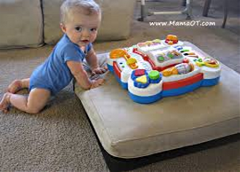
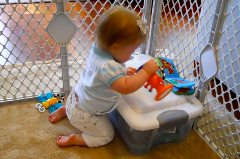
-
- You can encourage your baby to maintain their balance by standing or kneeling in front of them.
- Initially you may need to support your baby in standing by holding their hands or supporting them around the waist. Gradually reduce the support so they are standing independently.
- Turn balancing into a game. Help your baby to stand up and count how long they can stay up before they tumble. Give them praise after each attempt.
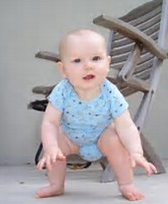
- Once your baby is more confident in standing try playing games that involve both hands i.e. put your hands on your head, point to your ears, hands on tummy etc.
- Motivate your baby to keep their balance by giving them praise, clapping and smiling.
- Encourage your baby to maintain a standing position by talking to them or sing a song.
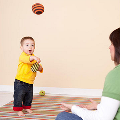
-
- By placing toys on the floor when your baby is in standing will encourage them to squat to pick the toy up. This will help your baby to increase his/her balance
- Using heavier or larger objects to pick up will improve their balance and stability.
- Place toys on the floor that your baby could stack, post or drop into a basket at a higher level. Encourage them to squat down and pick up the toys then reach up high to complete the task.
- Encourage your baby to follow simple tasks. For example, asking them to collect certain toys from the floor.
Song ideas
- Sing “heads, shoulders, knees and toes” to encourage them to bend down.
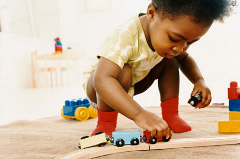
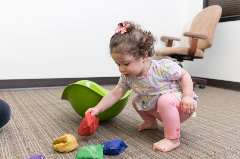
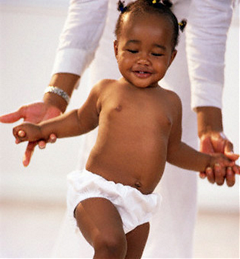
Learning to walk
-
- To encourage standing you can support by holding both hands or by encouraging them to stand holding onto furniture.
- An ideal place to learn to cruise (walking along furniture) is at the sofa or couch. Encourage your baby to get into standing with their favourite toy on the couch, then start to shift the toy to the right/left.
- Progress your baby’s walking by encouraging them to cruise between stable objects or furniture that are within close proximity.
- Cruising sideways along furniture using toys to get their attention and take some steps. Once your baby is more confident they will be able to cruise forward facing, with one hand on the furniture.
- To improve confidence you can try passing them toys from behind so they get used to letting go of the furniture with one hand.
- Simple phrases like 'Where is your toy?' or 'Bring your toy' could help to encourage your baby to cruise around the furniture.
Song ideas
- Sing 'if you are happy and you know it clap your hands' to encourage them to let go of the sofa.
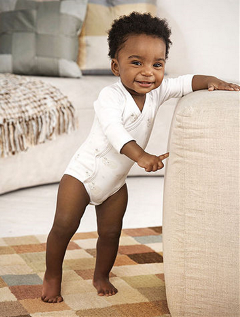
-
- Start by encouraging your baby to walk to the edge of the couch. Direct their attention by placing toys on furniture nearby.
- To progress your baby’s balance and stability it may be easier for them to walk barefoot when practicing at home.
- After a while the baby will be moving confidently between both pieces of furniture. Slowly move the furniture further away to increase the distance they need to walk.
- Encourage your baby to reach toward the toy, grasping onto the nearby furniture.
- Gradually your baby will become more confident to take some steps away from furniture.
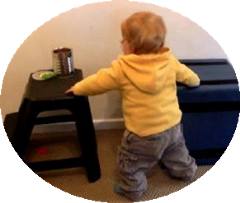
-
- Walking with push and pull toys may help your baby improve their confidence when up on their feet. They may walk with a wide base of support to help them stabilise.
- To achieve more stability you can place heavy books on top to slow the trolley down/dolls pram.
- Encourage your baby to push the trolley. You may need to help them guide the trolley at first.
- Be careful on wooden floors as the trolley may run away from them. They may also find it harder to push on carpet.
- You can encourage your baby to collect toys/items for you and put them in their trolley.
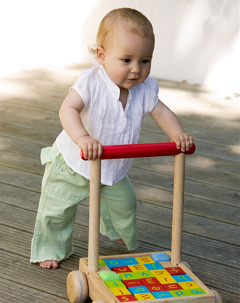
-
- When supporting your baby to walk guide them from their hips or hold their hands lower down rather than above their head.
- As your baby becomes more stable on their feet try giving them less support, making them work to keep their balance
- Progress walking by loosening your grip or offering one hand only, rather than two. From there try bridging the gap with a teddy or a hoop.
- Avoid wearing shoes inside so your baby can feel their feet on the floor and experience different textures.
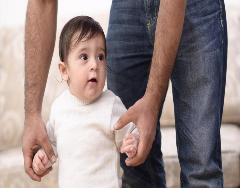
-
- Your baby may walk with their hands up in the air and feet wide apart. This helps them to gain stability and balance. By passing them a toy or a ball to hold , it will encourage them to bring their hands down and challenge their balance further.
- By walking on uneven surfaces or over objects this will improve your baby's balance and special awareness.
- Trying to climb up stairs will help your baby improve their coordination and strength.
- Encourage walking between two adults making sure they have their balance first. Give them praise when they take some steps independently.
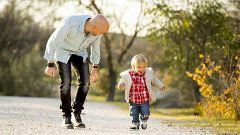
Baby equipment
Your baby will need to go in a car seat, baby seat, or other type of baby equipment at some time during the day.
We recommend that you avoid leaving your baby in a baby seat for longer than 30 minutes, unless you are travelling. This is because they restrict your baby from moving freely.
We also recommend that the use of baby walkers and door bouncers is limited to no more than 15 minutes at a time. Equipment that supports a baby in a standing position does not help your baby learn to walk. It can give an unnatural experience of standing and has been shown to be unsafe.

